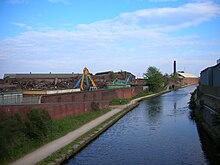
Matthew Boulton was an English businessman, inventor, mechanical engineer, and silversmith. He was a business partner of the Scottish engineer James Watt. In the final quarter of the 18th century, the partnership installed hundreds of Boulton & Watt steam engines, which were a great advance on the state of the art, making possible the mechanisation of factories and mills. Boulton applied modern techniques to the minting of coins, striking millions of pieces for Britain and other countries, and supplying the Royal Mint with up-to-date equipment.

Soho House is a museum run by Birmingham Museums Trust, celebrating Matthew Boulton's life, his partnership with James Watt, his membership of the Lunar Society of Birmingham and his contribution to the Midlands Enlightenment and the Industrial Revolution. It is a Grade II* listed 18th-century house in Handsworth, part of Birmingham since 1911, but historically in the county of Staffordshire. It was the home of entrepreneur Matthew Boulton from 1766 until his death in 1809, and a regular meeting-place of the Lunar Society.

Smethwick is an industrial town in Sandwell, West Midlands, England. It lies 4 miles (6 km) west of Birmingham city centre. Historically it was in Staffordshire and then Worcestershire before being placed into then West Midlands county.
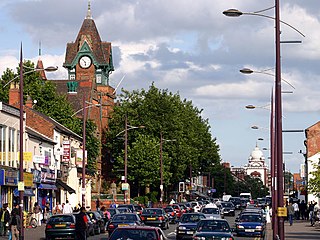
Handsworth is an inner-city area of Birmingham in the West Midlands, England. Historically in Staffordshire, Handsworth lies just outside Birmingham City Centre and near the town of Smethwick.
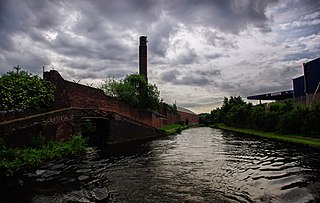
Soho is an area that is in Central Birmingham and Smethwick, approximately 2 miles north west of Birmingham city centre on the A41. The name is an abbreviation of South House, denoting that it was located to the south of Handsworth. The section of the A41 separating Handsworth from Winson Green is known as Soho Road.
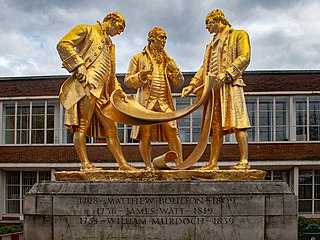
Boulton & Watt was an early British engineering and manufacturing firm in the business of designing and making marine and stationary steam engines. Founded in the English West Midlands around Birmingham in 1775 as a partnership between the English manufacturer Matthew Boulton and the Scottish engineer James Watt, the firm had a major role in the Industrial Revolution and grew to be a major producer of steam engines in the 19th century.

The Smethwick Engine is a Watt steam engine made by Boulton and Watt, which was installed near Birmingham, England, and was brought into service in May 1779. Now at Thinktank, Birmingham Science Museum, it is the oldest working steam engine and the oldest working engine in the world.

The Soho Manufactory was an early factory which pioneered mass production on the assembly line principle, in Soho, Birmingham, England, at the beginning of the Industrial Revolution. It operated from 1766–1848 and was demolished in 1853.
Avery Weigh-Tronix is a subsidiary of Illinois Tool Works specialising in industrial weighing machines. Its headquarters stands on the site of the Soho Foundry in Smethwick, West Midlands, England. The company additionally has a United States-based manufacturing and retail manufacturing plant. The company is one of the largest suppliers of weighing devices. The company is registered as Avery Weigh-Tronix, Ltd. in the UK and Avery Weigh-Tronix, LLC in the US.

Black Patch Park is a park in Smethwick, West Midlands, England. It is bounded by Foundry Lane, Woodburn Road, Perrott Street and Kitchener Street, at grid reference SP038888.

The Engine Arm or Birmingham Feeder Arm near Smethwick, West Midlands, England, is a short canal which was originally part of a feeder tunnel for a pumping engine. When the Smethwick flight of locks were reduced from six to three, the pumping engine was moved to a new site, which allowed part of the feeder tunnel to be opened up and made navigable, so that coal supplies for the engine could be delivered by barge. The Engine Arm also supplied the pumped water to the 473-foot (144 m) Wolverhampton level of the lowered summit. The arm was extended between 1825 and 1830 by Thomas Telford to carry water from Rotton Park Reservoir to the Old Main Line of the BCN Main Line Canal, and the Engine Arm Aqueduct was inserted to carry it over the new main line constructed at that time, which was 20 feet (6.1 m) lower. The arm is now managed by the Canal and River Trust and the basin beyond the site of the pumping station, which was replaced by a new engine house near Brasshouse Lane bridge in 1892, is used for residential moorings.
The BCN Main Line, or Birmingham Canal Navigations Main Line is the evolving route of the Birmingham Canal between Birmingham and Wolverhampton in England.
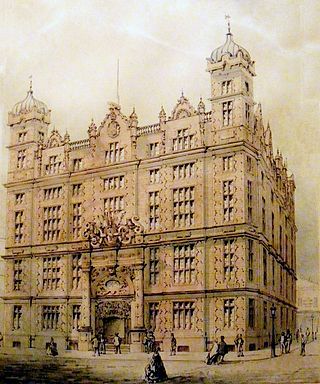
Liverpool Sailors' Home, was open for business in Canning Place, Liverpool, England, from December 1850 to July 1969. The home was designed to provide safe, inexpensive lodging for sailors, and to offer educational and recreational opportunities, in contrast to the temptations on offer in the docklands area.
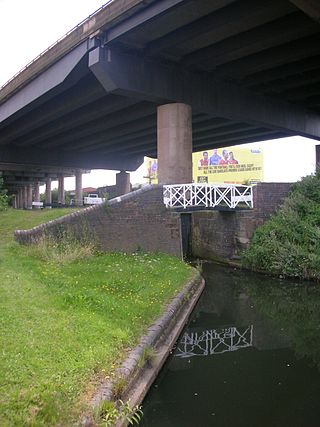
Spon Lane Junction is the original junction of the Wednesbury Canal and the Birmingham Canal, near Oldbury in the West Midlands, England.
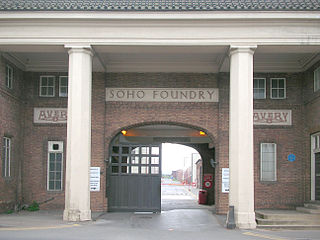
W & T Avery Ltd. was a British manufacturer of weighing machines. The company was founded in the early 18th century and took the name W & T Avery in 1818. Having been taken over by GEC in 1979 the company was later renamed into GEC-Avery. The company became Avery Berkel in 1993 when GEC acquired the Dutch company Berkel. After the take over by Weigh-Tronix in 2000 the company was again renamed to be called Avery Weigh-Tronix with Avery Berkel continuing to operate as a brand. The company is based in Smethwick, West Midlands, United Kingdom.
Smethwick is a town in the Metropolitan Borough of Sandwell, in the West Midlands of England.

Galton Valley Canal Museum is a small museum, located in Smethwick, England, on the border with Birmingham and alongside the BCN Main Line canals. The Museum tells the story of the development of the Galton Valley canals and those who designed, built and worked on them.

Old Bess is an early beam engine built by the partnership of Boulton and Watt. The engine was constructed in 1777 and worked until 1848.
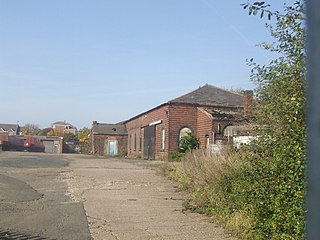
The Boat Gauging House is a building in Tipton, West Midlands, England. It is situated by the Main Line of the Birmingham Canal Navigations, and was used for calibrating new canal boats in order later to ascertain the weight of cargo carried. It is a Grade II listed building.



